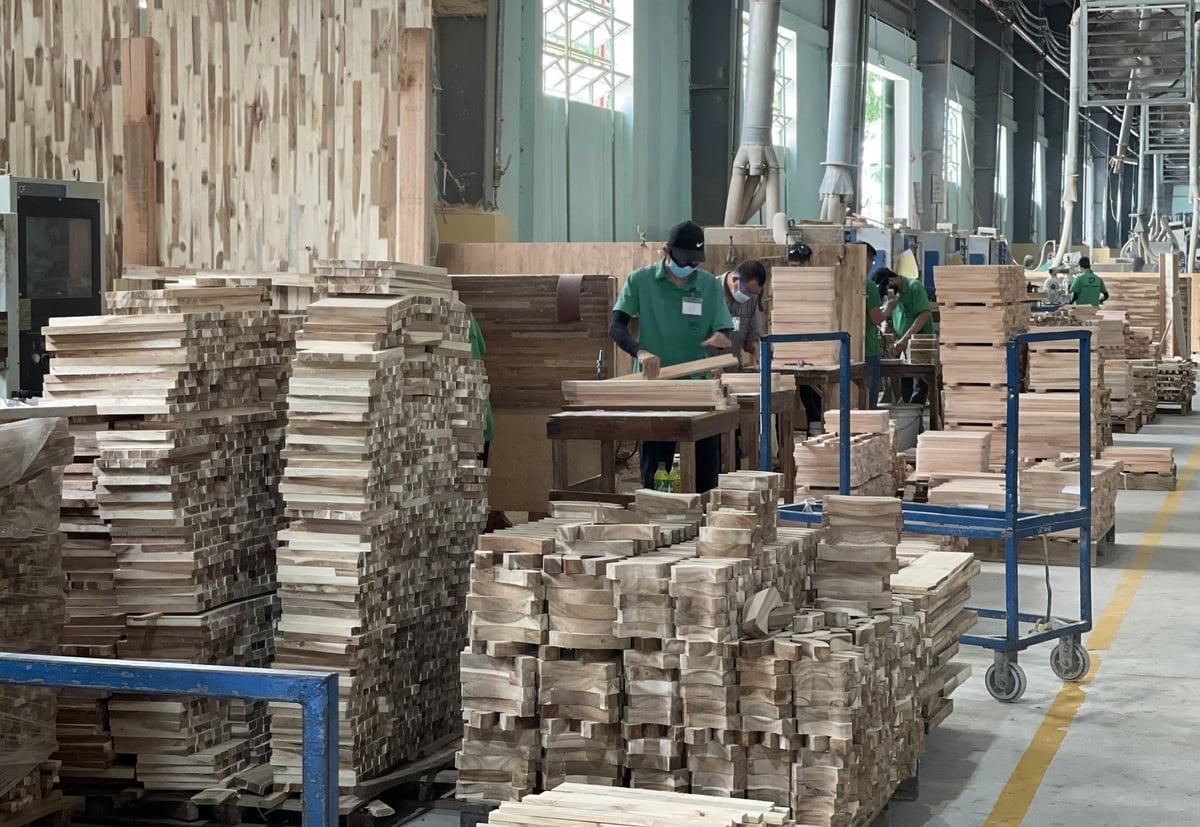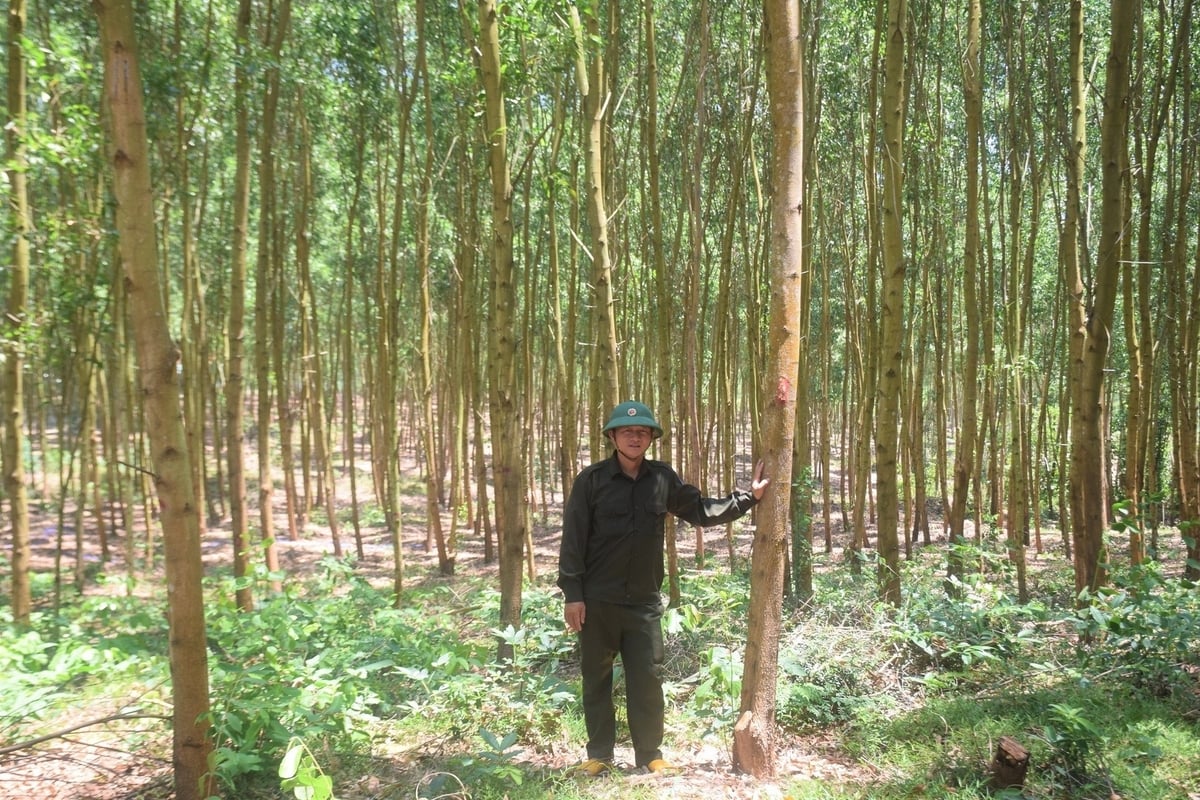January 2, 2026 | 16:12 GMT +7
January 2, 2026 | 16:12 GMT +7
Hotline: 0913.378.918
January 2, 2026 | 16:12 GMT +7
Hotline: 0913.378.918
According to Mr. Nguyen Tuan Thanh, Standing Vice Chairman of the People's Committee of Gia Lai Province, the European Union (EU)'s regulation on the management of import and export of products related to deforestation and forest degradation has created considerable difficulties and major challenges for various sectors in Vietnam, including the exported wood processing industry in Gia Lai.

The People's Committee of Gia Lai Province has implemented an action plan to adapt to the European Union's anti-deforestation regulation, aiming to remove difficulties for exported wood processing enterprises. Photo: Dinh Thung.
"Therefore, the People's Committee of Gia Lai Province has introduced adaptive solutions to comply with EUDR regulations, aiming to remove difficulties for hundreds of exported wood processing enterprises operating in the locality," Mr. Nguyen Tuan Thanh stated.
Since March 2025, the People's Committee of the former Binh Dinh Province (now Gia Lai Province) has implemented an action plan to adapt to the European Union's anti-deforestation regulation within its jurisdiction.
Accordingly, the Provincial People's Committee requires forest owners to demonstrate the origin of forest products when participating in the product supply chain and fully provide information on the legality of raw wood. Legal raw wood must be cultivated on legally recognized land, with clear details on area, geographic location, tree species, age, and yield for each forest plot.
When harvesting planted forest timber for sale to organizations or individuals, forest owners must provide complete legal documentation on timber origin in accordance with Circular 26/2022/TT-BNN and Circular 22/2023/TT-BNN issued by the Ministry of Agriculture and Rural Development (now the Ministry of Agriculture and Environment) on the management and traceability of legally sourced timber. They must also provide geographic location for the planted forest areas harvested as required by the EUDR.
"For production forest land that is legally used but has not yet been issued land use certificates, the Provincial People’s Committee requires forest owners to contact local governments to address legal issues related to forested land areas that have not been issued the red book, or those that have the red book but lack geographic location," said Mr. Le Duc Sau, Head of the Gia Lai Forest Protection Sub-Department.
The People's Committee of Gia Lai Province has also requested the Forest Products Association to submit registration documents for classification as Group I enterprises in accordance with the Government's regulations on the Vietnam Timber Legality Assurance System (VNTLAS), as amended and supplemented by Decree No. 102/2020/ND-CP.

Gia Lai tightens control over the supply chain and traceability of legally planted forest timber. Photo: Dinh Thung.
In practice, wood processing and exporting enterprises in the former Binh Dinh province primarily purchase planted forest timber from neighboring provinces. Thus, the Provincial People's Committee has requested the Forest Products Association to instruct businesses to ensure the legality of forest products when purchasing raw materials and to clearly define the geographic location of the planting areas to avoid violations of EUDR regulations.
"The Provincial People's Committee has also directed relevant departments, local People's Committees, and involved units to implement measures to adapt to EUDR requirements. At the same time, develop appropriate solutions to verify the legality of forest plantation plots that were previously cultivated but not yet recognized under the Land Law, or that have been recognized but lack specific location," said the Head of the Gia Lai Forest Protection Sub-Department.
According to legal regulations on forestry, legally planted forest owners have the right to decide on afforestation and forest harvesting. They are free to transport and circulate domestically without being subject to administrative procedures for verifying the origin of forest products.
However, forest owners must still ensure legal compliance during the planting, harvesting, and trading of forest products to facilitate the participation of organizations and individuals in the supply chain in alignment with EUDR requirements.
The Gia Lai Department of Agriculture and Environment has directed the Provincial Forest Protection Sub-Department to guide organizations and individuals in declaring forest product documentation in accordance with Circular No. 26/2022/TT-BNN and Circular No. 22/2023/TT-BNN issued by the Ministry of Agriculture and Rural Development (now the Ministry of Agriculture and Environment).
It also provides guidance for enterprises involved in the planting, harvesting, and supply of planted forest timber, as well as wood processing, importing, and exporting businesses, to register and submit dossiers for classification as Group I enterprises in line with the Government's regulations.
The Gia Lai Department of Agriculture and Environment has also directed the Provincial Forest Protection Sub-Department to coordinate with local governments in verifying the geographic location of legal forest plantation areas, particularly in cases where land use certificates lack information about the geographic location of the allocated plots. The sub-department is also requested to work with relevant stakeholders to develop a comprehensive database and digital maps of current forest conditions, ensuring sufficient information for the control, traceability, and geographic indication of timber and wood products.
"Currently, the Vietnamese Academy of Forest Sciences is piloting the iTwood system to manage the supply chain and ensure traceability of legally planted forest timber. Once the iTwood system is officially put into operation, forest rangers will guide forest owners, enterprises, and wood processing facilities in registering accounts, updating planting areas, managing the supply chain, and tracing the origin of legally planted forest timber," said Mr. Le Duc Sau, Head of the Gia Lai Forest Protection Sub-Department.
Translated by Thu Huyen
/2025/12/31/0650-2-160930_936.jpg)
(VAN) Alternate wetting and drying (AWD) irrigation helps reduce methane emissions, laying a solid foundation for sustainable rice production and serving as a basis for the formation of carbon credits.

(VAN) From extensive shrimp ponds, baskets of don gathered on the mudflats, to boats carrying visitors to watch birds, all livelihoods here depend on clean water, green forests, and the calls of migratory birds.
/2025/12/26/0703-3-204813_117.jpg)
(VAN) Transparency in information and listening to local people have helped address ground clearance bottlenecks and build social consensus, thereby accelerating the progress of the JICA3 irrigation project.
/2025/12/27/0609-3-233846_327.jpg)
(VAN) The JICA3 project is expected to become a 'water shield,' helping control saltwater intrusion, proactively secure water resources, protect livelihoods, and promote sustainable development in coastal areas.
/2025/12/26/5654-3-164509_655.jpg)
(VAN) As Viet Nam makes strong commitments toward achieving net-zero emissions, controlling and reducing methane emissions in livestock production is increasingly becoming a mandatory requirement.

(VAN) 'People, Primates, Plants: Co-managing Biodiversity and Improving Livelihoods in Vietnam' (the PPP Project) is an international initiative implemented in Vietnam by BGCI, CEGORN, and ICRAF/World Agroforestry.

(VAN) Dak Nong established a risk-level zoning map for coffee, built a digital data platform for the sector, and promoted certified production in line with EUDR.